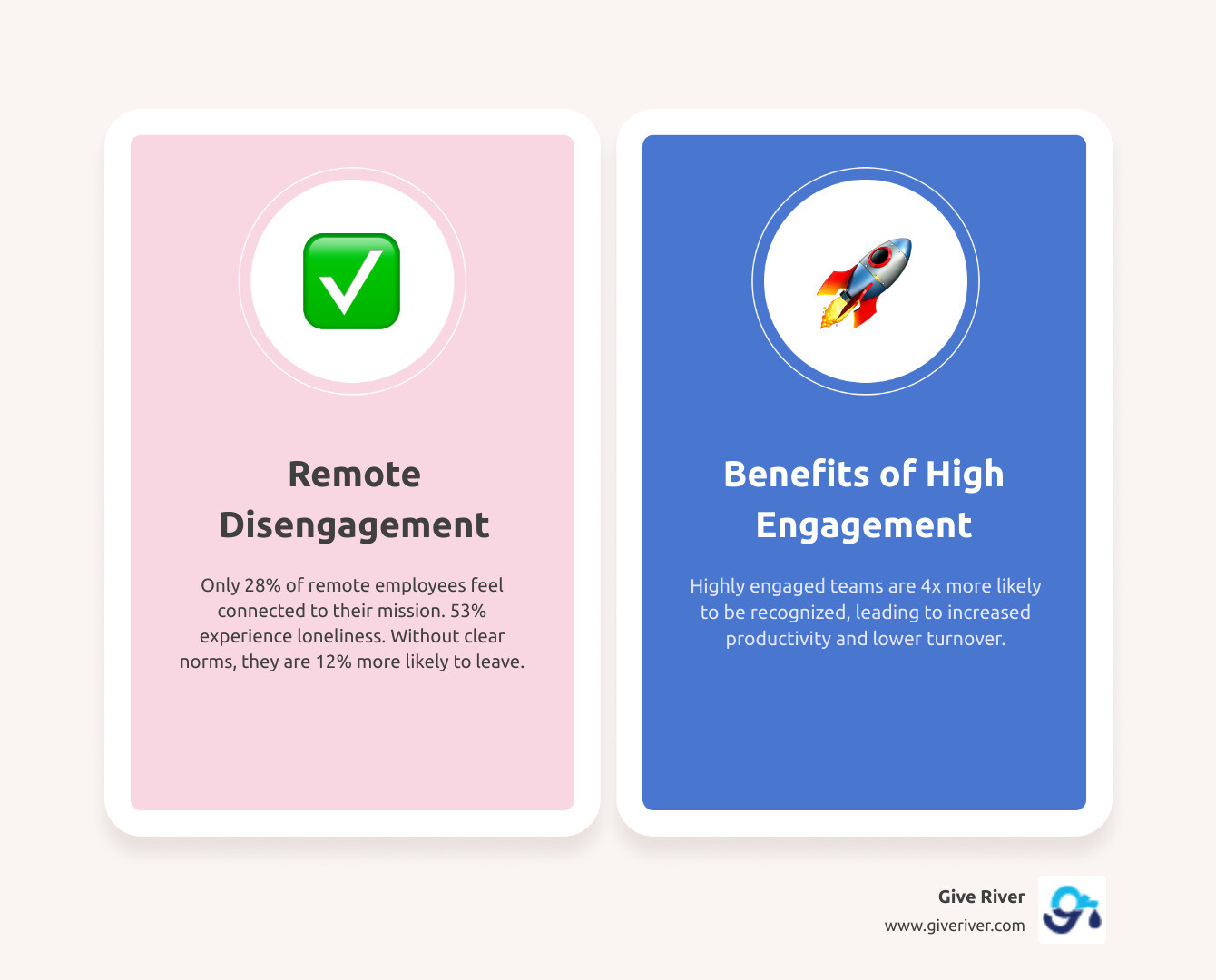Beyond the Screen: Boosting Remote Employee Engagement
Discover 15 remote working team engagement ideas to boost morale, connection, and combat isolation in your distributed team.

Why Remote Engagement is More Than Just Virtual Happy Hours
When it comes to nurturing thriving remote teams, effective remote working team engagement ideas are no longer a nice-to-have - they're a business imperative. Here are some of the most impactful strategies:
- Foster genuine connection: Replicate informal office interactions through virtual coffee breaks, digital water coolers, and engaging team-building games.
- Prioritize recognition and appreciation: Implement peer-to-peer shout-out channels and celebrate milestones to make every team member feel valued.
- Invest in growth and professional development: Offer online training, virtual mentoring, and clear career pathing opportunities.
- Promote holistic wellness and flexibility: Support mental health, encourage physical activity, and provide flexible work arrangements.
- Build a purpose-driven culture: Connect employees to the organizational mission through virtual volunteering and clear communication.
- Empower managers: Equip leaders with the tools and training to coach their remote teams effectively and build trust.
The shift to remote work has brought unprecedented flexibility, but it has also surfaced significant challenges. Many remote employees report feeling isolated, and data from Gartner shows a concerning trend: only 28% of remote employees felt connected to their organizational mission and purpose in 2023, a significant drop from 2021. This disconnection is a major concern, with studies indicating that employees are 12% more likely to leave their workplaces if explicit hybrid work norms aren't established.
The "water cooler conversations" that once happened organically in an office environment are largely absent in remote setups, leading to feelings of loneliness among remote workers. This highlights the urgent need for intentional, strategic remote working team engagement ideas that bridge geographical gaps and foster a strong sense of belonging. Moving beyond simple virtual happy hours, a holistic approach to engagement can transform your remote workforce into a connected, highly motivated, and productive unit.
As Meghan Calhoun, Co-Founder of Give River, I've spent over two decades in high-pressure environments, learning how to foster joy, balance, and growth, culminating in a passion for innovative remote working team engagement ideas that build healthier, more fulfilling workplaces. Our platform is designed to transform workplace culture through gratitude, gamification, and generosity, creating a robust employee experience.

Remote working team engagement ideas terms at a glance:
- organizational culture in virtual teams
- wellbeing activities for virtual team meetings
- fun activities for online meetings
15 Actionable Remote Working Team Engagement Ideas to Boost Morale and Connection
The landscape of work has evolved dramatically, and with it, the challenge of keeping remote teams not just productive, but truly engaged. When remote employees feel disconnected, the ripple effects are significant—higher turnover rates, decreased productivity, and a culture that struggles to thrive. But here's what we've learned from working with distributed teams: an intentional focus on engagement can transform a scattered workforce into a cohesive, high-performing unit.
These remote working team engagement ideas aren't just theoretical concepts—they're proven strategies that address the real challenges remote workers face every day. Let's explore the approaches that make the biggest difference.
Foster Genuine Connection and Combat Isolation
The silence where office laughter once lived is one of the most challenging aspects of remote work. Without those spontaneous hallway conversations or the energy of a busy workspace, isolation creeps in quickly. In fact, 53% of men and 39% of women have experienced loneliness while working remotely. The key is creating intentional moments that feel natural and genuine.

Virtual coffee breaks and digital water coolers have become lifelines for remote teams, but they work best when they feel organic rather than forced. Some of our most successful teams create "always-on" Zoom rooms where people can drop in for casual chats, or they dedicate Slack channels specifically for non-work conversations. One team we know keeps a shared Google Doc called "The Water Cooler" where employees share weekend plans, pet photos, and random thoughts throughout the day.
Team-building games and virtual icebreakers get a bad rap sometimes, but when done right, they spark genuine laughter and connection. The secret is making them optional and actually fun. Games like "Two Truths and a Lie" or virtual escape rooms create shared experiences that people remember long after the call ends. We've seen teams bond over online Pictionary sessions and find surprising talents during virtual game shows. Check out our guides on Best Free Virtual Games and Fun Ice Breaker Questions for Virtual Meetings for ideas that actually work.
Show and Tell might sound elementary, but it's incredibly powerful for adult teams. When someone shares a meaningful object from their desk or tells the story behind a photo on their wall, colleagues get a glimpse into their world beyond work screens. These moments build empathy and understanding in ways that traditional work interactions simply can't.
The concept of virtual community building goes deeper than individual activities. It's about creating spaces where people with shared interests or experiences can connect. This might mean virtual employee resource groups that celebrate diversity and inclusion, or using platforms that simulate the natural flow of networking events. For more comprehensive strategies, explore our thoughts on Virtual Community Building.
Prioritize Recognition and Appreciation
Recognition is the heartbeat of engagement, and in remote settings, it needs to be more intentional than ever. When employees feel recognized at work, they're four times more likely to be actively engaged. But without the casual "great job" moments that happen naturally in offices, structured recognition becomes essential.
Peer-to-peer recognition creates something beautiful—a culture where appreciation flows naturally between colleagues. Setting up dedicated shout-out channels or creating recognition hashtags gives people permission to celebrate each other publicly. We've seen teams where recognizing a colleague becomes part of the weekly routine, with people taking turns highlighting someone's contributions.
Digital rewards and milestone celebrations make recognition tangible in a virtual world. This goes beyond verbal praise to include virtual badges, e-gift cards, or even simple certificates created in Canva. When teams celebrate work anniversaries, project completions, or personal achievements with the same enthusiasm they would in person, employees feel genuinely valued.
The power of gratitude shows up in creative ways too. Some teams maintain "Gratitude Walls" on digital whiteboards where members write what they're thankful for—both work-related and personal. This simple practice shifts the entire team's mindset toward positivity and mutual support.
While platforms like Bonusly and Kudos offer solid recognition tools, Give River takes a unique approach by weaving recognition into a broader fabric of engagement. Our platform connects appreciation with gamification, personal wellness, and professional growth, creating what we call a "game of good deeds." This comprehensive approach doesn't just boost morale—it drives deeper fulfillment by connecting recognition to company values and personal development.
For deeper insights, explore our resources on The Power of Gratitude in the Workplace: Recognition Matters More Than You Think, Employee Recognition Programs, and Peer-to-Peer Recognition Activities.
Invest in Growth and Professional Development
Here's a concerning statistic: remote employees spend 25% less time learning than their office-based counterparts. This learning gap can quickly lead to stagnation and disengagement. When you invest in professional development for remote staff, you're sending a clear message that their growth matters to you.

Virtual mentoring programs create invaluable connections between experienced and newer employees. These relationships provide guidance, support, and help new hires integrate faster into the team culture. Micro-mentoring sessions, where knowledge about specific skills gets transferred in focused conversations, work particularly well in remote settings.
Online training and skill-sharing sessions serve a dual purpose—they develop capabilities while fostering connection. When employees lead sessions teaching colleagues new skills, it builds confidence and leverages internal expertise. Access to relevant online courses, webinars, and workshops shows your commitment to their growth journey.
Clear career pathing becomes even more critical for remote employees who might feel "out of sight, out of mind" when it comes to advancement opportunities. Regular discussions about growth during one-on-one meetings, coupled with accessible career maps, help remote workers see their future with the organization.
One creative approach we love is personal user manuals—documents where employees outline their work preferences, communication styles, and feedback preferences. This helps colleagues understand each other better and facilitates smoother collaboration while contributing to everyone's personal growth.
Dive deeper into these concepts with our guides on Personal Growth in Workplace, Professional Growth Programs, and Workplace Mentorship Software.
Promote Holistic Wellness and Flexibility with these remote working team engagement ideas
When home becomes office, the boundaries between work and life blur in ways that can increase stress and accelerate burnout. Supporting holistic wellness isn't just compassionate—it's strategic for sustaining engagement and productivity over the long term.
Work-life balance and flexible schedules represent more than employee perks; they're fundamental remote working team engagement ideas. Offering flexible hours or compressed workweeks can dramatically impact satisfaction levels. Given that 22% of remote employees struggle with work-life balance, encouraging people to "unplug" and set clear boundaries becomes essential. Remote work allowances that help create ergonomic home office setups also contribute indirectly to overall wellbeing.
Mental health support and virtual meditation address the psychological challenges of remote work head-on. This might include access to mental health resources, therapy stipends, or organized virtual mindfulness sessions. These therapeutic activities help reduce anxiety and stress, making team members more present and centered during work hours.
Fitness challenges and wellness stipends encourage physical activity through creative approaches like virtual fitness challenges where teams track progress together, online yoga classes, or "walking 1:1s" where colleagues chat while strolling in their respective neighborhoods. Wellness stipends empower employees to choose activities that fit their individual needs and preferences.
The broader impact of health and wellness initiatives extends far beyond individual wellbeing. Engaged employees are less likely to struggle with chronic diseases and more likely to maintain healthier lifestyles overall. When companies actively support wellbeing, they demonstrate genuine care, which fosters loyalty and reduces absenteeism.
Learn more about creating comprehensive wellness strategies through our resources on Workplace Wellness Initiatives, Employee Wellbeing Programs, and Employee Wellness and Productivity.
Putting it All Together: Creating and Measuring Your Engagement Strategy
Implementing individual remote working team engagement ideas is a great start, but true change comes from a holistic strategy and the ability to measure its impact.
Build a Purpose-Driven Culture and Measure What Matters
For remote employees, maintaining a connection to the organizational mission and purpose can be challenging, with only 28% feeling connected. Fostering a sense of shared purpose is key to deep engagement.

- Virtual Volunteering & Community Impact: Engaging in corporate social responsibility (CSR) initiatives, even virtually, can significantly boost a sense of purpose and connection. Organizing virtual packing events for MATTERbox, participating in virtual charity runs, or collaborating on online projects for non-profits allows remote teams to contribute to the community together. This fosters camaraderie and a shared sense of making a difference.
- Connecting to Mission through Communication: Regularly communicate company updates, goals, and successes through virtual town halls. Senior leadership should share their vision and answer questions, ensuring remote employees feel informed and aligned with the company's direction. Clearly linking individual roles to the larger organizational mission helps employees understand their impact.
- Employee Feedback & Surveys: To truly understand what resonates with your remote team, you must ask them. Regular pulse surveys are essential for gathering feedback on engagement levels, well-being, and activity preferences. Acting on this feedback demonstrates that employees are heard and valued, fostering trust and improving initiatives.
- Measuring Success: We can't improve what we don't measure. Key Performance Indicators (KPIs) for remote engagement include employee surveys (Employee Engagement Index, eNPS), retention rates, productivity metrics, and participation rates in voluntary activities. By consistently tracking these, we can refine our strategies and demonstrate the ROI of our engagement efforts. Give River's platform helps automate these feedback loops and provides actionable insights, allowing companies to tailor their approach and ensure maximum impact.
The Manager's Role in Driving Success with remote working team engagement ideas
Successful remote employee engagement heavily relies on effective management. Employees don't leave companies; they often leave their managers.
- Leadership Accountability & Coaching Approach: Managers of remote teams need specialized training. They should adopt a coach-like approach, focusing on micro-understanding of team members' needs, setting clear priorities, and problem-solving collaboratively. This means moving beyond micromanagement and empowering employees with autonomy.
- Clear Communication & Expectations: Managers are the frontline communicators. They must ensure clarity in tasks, deadlines, and feedback, potentially using 30-60-90-day plans for new hires. Regular one-on-one video calls are crucial for personalized check-ins, addressing concerns, and discussing career growth.
- Effective Onboarding: A standout remote onboarding experience is critical for early engagement. This includes a buddy system, clear communication about company culture, and providing all necessary resources and equipment. A smooth onboarding process ensures new remote employees feel connected and supported from day one.
- Building Trust & Creating an Inclusive Environment: Managers foster psychological safety, encouraging employees to be vulnerable and share concerns. This involves actively listening to feedback, acting on it, and celebrating both individual and team successes. Promoting diversity, equity, and inclusion (DEI) ensures all voices are heard and valued, creating a workplace where everyone feels they belong.
Conclusion
The journey to truly engaged remote teams is ongoing, requiring intentionality, creativity, and a genuine commitment to employee well-being. We've explored a wide range of remote working team engagement ideas, from fostering genuine connections through virtual coffee breaks and games to prioritizing recognition, investing in growth, promoting wellness, and building a purpose-driven culture. Each of these elements contributes to a more connected, motivated, and productive remote workforce.
The risks of disengaged remote employees – from high turnover to decreased productivity and a lack of connection to the company's mission – are significant. However, by embracing a holistic and data-driven approach to engagement, organizations can transform these challenges into opportunities.
At Give River, we understand that true employee fulfillment goes beyond basic engagement. Our unique 5G Method integrates gratitude, gamification, generosity, guidance, and growth content to create a comprehensive employee experience that builds happier, healthier, and high-performing teams. By focusing on these core pillars, we empower companies to cultivate a thriving workplace culture, ensuring their remote employees feel valued, connected, and inspired to contribute their best.




